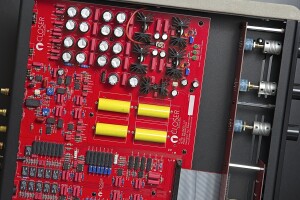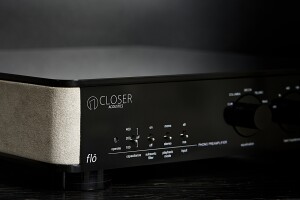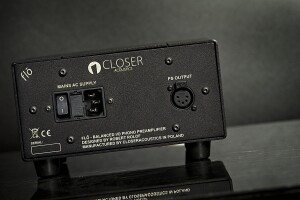My recent experience with the excellent integrated 300B SET amplifier called Provocateur encouraged me to continue an adventure with products of this Polish boutique manufacturer. The second one, also developed by Robert Rolof and the Grodecki brothers team, that arrived for assessment is the Closer Acoustics Flō MM/MC phono preamplifier. This time, no tubes on board, yet the magic, as it turns out, is still there …
Introduction
The Provocateur’s review was my first close encounter of one of the Closer Acoustic’s product and the brand itself, as well as an introduction of the brand to our Reader. As usually in such cases, it included some basic information about the people behind the company (if you haven’t read it so far, let me suggest you do – see HERE), so this time let me skip most of this part and stick to the very basic information. This first experience with the 300B SET integrated strongly suggested, that Mr. Jacek Grodecki and his team truly know what they are doing. For several years the company focused on high-sensitivity loudspeakers, but in 2017 they presented their first take on a Single Ended Triode amplifier, which later evolved into the reviewed Provocateur Signature version.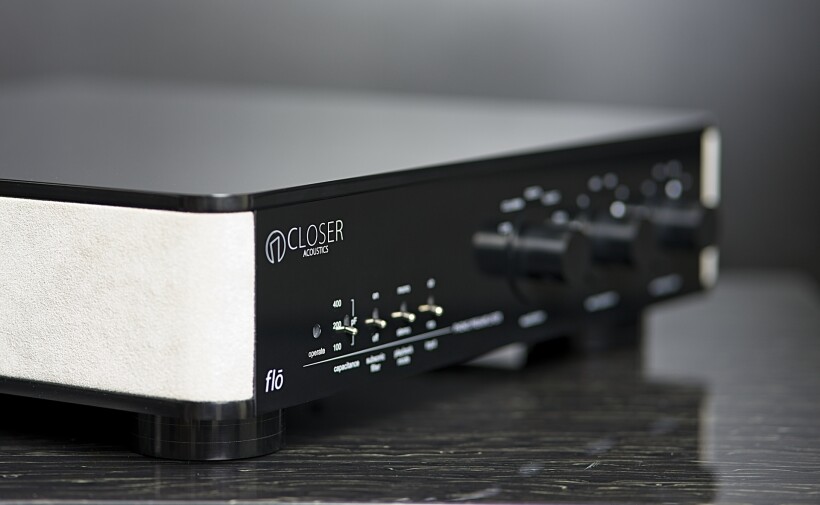
A few months ago Closer Acoustics introduced a new phono preamplifier (previously the company offered a model called Stelvio) which allows them to offer an (almost) complete setup (one still needs a turntable or digital source and accessories including cables, obviously) to those who share their sound philosophy. One of the members of the team that developed both, the Provocateur and the tested phonostage called Flō, is a man well known in the audio community, mainly due to phono preamplifiers he’d developed under his own brand. His name is Mr. Robert Rolof. Another part of his activity though, following footsteps of many other renown designers, has also been a development of audio products for other brands. He was the designer behind, for example, the RCM Sensor Prelude phonostage, and for the past several years he’s also been cooperating with the Closer Acoustics. The aforementioned, and based on my experience with it, outstanding first fruit of this cooperation was the Provocateur. The second one, subject of this test, is the new Flō phono MM/MC preamplifier that aspires to be one of the best devices of its kind. I’ll try to answer the question whether it actually belongs to the top tier of phono preamplifiers and if it is worth attention of demanding vinyl records aficionados.
We will all remember the 2020 for a long time, mainly due to the pandemic, but also because of its numerous consequences. One of them, certainly not the most important one on a global scale, but paramount for the audio industry, was the lack of presentations, audiophile gatherings (at least larger scale ones), shows and exhibitions. Probably one of the latter, and judging by timing of the announcement of the new phono preamplifier, most likely the Audio Video Show in Warsaw, would feature an official premiere of the Flō. As it wasn’t possible, interested parties have no choice but to read any available reviews or take a trip (following proper sanitary regime) to the company’s headquarters in Jastrzębie Zdrój to assess it (in the brand’s reference system) for themselves. For those who have not read the Provocateur review, let me explain once more that the adopted approach of the Closer Acoustics is to offer its customers a chance to purchase an almost complete stereo system. Almost, as the choice of the source/s and all the accessories is still on the side of the user of such a setup. Still, with the introduction of the Flō they are able to offer the phono preamplifier, the aforementioned integrated amplifier and a pair of loudspeakers (one of the six currently available models) which more than many competitors have to offer.
Design & Features
The idea of offering customers complete systems, which is by no means a new one, is a matter of not only developing components flawlessly working together towards combined performance of certain quality and character, but also ones that agree aesthetically. Both, the performance, and the looks, are important, and as those who spent months, sometimes years even, building their dream sets, know all too well, it is not an easy task at all. By buying a complete set from one manufacturer, you can solve the issues of matching performance and aesthetics in one go, so to speak. Of course, you need to find a brand whose products offer sound, appearance, and quality of workmanship and finish that satisfy your expectations and taste. What the Closer Acoustics has to offer is obviously not a universal answer to the needs of all potential buyers, but those who find their sound philosophy attractive will probably have no problem with accepting the aesthetics due to the multitude of available finishes and top quality make&finish.
Both, the Flō and Provocateur versions, that I received for testing, featured side panels finished with Alcantara in the same bright gray-ish color, while the top and front panels were made of black acrylic. It is worth noting that also in both cases, the devices featured magnetic tops, which made peaking inside particularly easy. Which proves, by the way, that the company is simply proud of their design and is not afraid to show it to any interested party. Coming back to the finish – the Alcantara is an elegant material available in a wide range of colors, making it easy to choose one that suits individual requirements, taste or even an interior design of the listening room. One can also opt for a more traditional finish that Closer Acoustics have offered for several years, i.e. a beautiful wood (used instead of the Alcantara). Both versions look great, and the quality of workmanship and attention to details clearly show that the Silesian company wants to meet the aesthetic needs of even the most demanding customers.
As the Flō’s features prove, it is also quite a versatile product that will work with (I should probably add – almost – because one could probably find some exotic exceptions) any MM or MC cartridge available on the market. The preamplifier is equipped with both, the traditional RCA inputs and the less common XLR sockets. According to the manufacturer, Flō uses a proprietary solution that allows you to connect a symmetrical signal from the cartridge even using RCA cables, but the XLR inputs is also there for the convenience. The users have also two outputs at their disposal – RCA and XLR ones, and the rear panel is completed with a gold-plated ground terminal and a power inlet for connecting an external power supply.
The tested device features also all necessary adjustments enabling optimal support for any cartridge. With the knobs on the front panel, one chooses, among others, an input impedance, and there are six values available: 30, 75, 150, 400, 1000 and 47000 Ω. Another knob selects the type (parameters) of the correction curve (apart from the traditional RIAA, there are also four others: TELDEC, DECCA, COLUMBIA and CCIR). Equalization is carried out passively in two independent stages, separately for low and high frequencies. When it comes to the RIAA curve, an additional filter correcting the operation of the circuit in the 50kHz range was used, and the signal path uses current coupling with no interstage capacitors.
The third knob allows users to select proper gain. For the sake of simplicity, the values of the latter parameter are determined using the values of the cartridge output signal level (0.25, 0.4, 0.65, 0.9, 1.5 and 2.5 mV, or 73, 69, 65, 60, 55 or 50 dB, respectively). Usage of other functions is also quite easy as they are operated with simple flip switches, also placed on the front of the device. The first one (from the left) chooses one of the three input capacitance values – 100, 200 or 400 pF. The next one enables / disables the subsonic filter, the third switches between the operating modes – mono or stereo, and the last one selects an active input (RCA or XLR). I bet that most users, at least those who often change the settings searching for optimal values, will truly appreciate how convenient placement of all the knobs and switches on the front is.
As I mentioned earlier, the preamplifier and power supply sections were separated in order to further improve sound quality. The housing of the external power supply may not be as elegant as that of the device itself, but it is aesthetically pleasing enough so that hiding it behind the rack is not necessary. The power supply is a symmetrical circuit equipped with ultra-fast rectifying diodes and polyester capacitors suppressing high-frequency impulse interference. The main filtration is based on Panasonic low-impedance long-life (up to 10,000 hours) electrolyte caps with a total capacity of over 50,000 microfarads. The two-stage power supply stabilization sports a circuit reducing voltage ripple by additional 15dB. An additional filter featuring polypropylene capacitors has been installed in the output of the power supply, improving its impedance characteristics. The power supply is features an IEC socket, enabling the users to use a power cable of their choice. Customer is provided with a proper cable to connect the PS with the phonostage.
Sound
One thing I noticed first right after turning the Flō on in my system was how completely quiet its operation is. Don’t get me wrong – I love tube devices for their sound, but the fact is that they rarely perfectly quiet, especially when it comes to applying high gain, which is the case for all MC phonostages. This is one of the reasons why I am a proud owner of two solid state phonostages (the other, quite significant, reason being the prices of the tube ones that I would love to have), and the tested flagship model from the Closer Acoustics also belongs to this family. As I mentioned in the previous paragraphs, it is a device that offers its users a lot of options that will help them to optimized the performance with a chosen cartridge. There are RCA and XLR inputs and outputs, a mono operation (for mono records and cartridges), a subsonic filter, as much as five equalization curves and six impedance and gain settings. In a word, it is a versatile device that will work perfectly with any low-level, but also high-level MC pickups, as well as with MM ones. It is also very simple and convenient to use, which is another of its advantages. While assessing the Closer Acoustics Flō’s performance I was using my excellent J. Sikora Standard Max turntable armed with the Kevlar KV12 tonearm (also by J.Sikora) with my trusted AirTight PC3 interchangeably with reasonably priced, yet offering a very good value for money, ZYX Ultimate 100. Let’s get to the sonic performance.
Ever since purchasing this album several months ago, I have been playing it while listening to almost every tested phonostage, turntable and cartridge (also in my own system, obviously). It is not always the first choice, but usually, whether I plan it or not, sooner or later I reach for it. I am talking about the Oleś brothers, Marcin and Bartłomiej, album called “Spirit of Nadir”. This is an unusual recording since it features only two instruments – a double bass of the former and the drums of the latter. Using seemingly modest means, these two amazing musicians tell an extremely colorful, engaging story, taking listeners on a journey through the desert that is dry and hot during the day, but cold at night, meandering freely between the Arabic and Indian themes. In theory, as there are only two instruments, this album shouldn’t be a particular challenge for any audio system or component. It’s just that while listening to it with every phono that came through my system during those several months, I was able to observe how much more information read by the stylus from the groove of this Audio Anatomy label release, the best phono preamplifiers were able to present compared to those of somewhat lesser quality.
The best ones from a good (as this is not a top audiophile quality) recording are able to extract a surprising amount of information and present it as a smooth, coherent, fascinating, fabulously spatial, relaxing musical story. The Flō is one of the two phono preamplifiers I listened to at that time, that turned this music into a real, totally immersive spectacle, one that demands attention from the very first to the very last note, despite some technical imperfections of the recording. The second phonostage, for the sake of clarity, was the Thoeress’s Phono Enhancer (see HERE), i.e., unlike the tested one, a tube design. It’s just that in this particular case “tube” describes its actual design, but less so (at least in common understanding of this term) its sonic character. Comparing these two while listening to this album, and many others that followed, based on what I heard, I would rather describe the Closer Acoustics Flō as the „tube-sounding” one. To be clear, by „tube sound” I do not mean any stereotypes, but rather the actual best qualities of this „ancient” technology.
This unique, but true, not forced or added by the system, smoothness and coherency of the sound are just some of them. An ability to render a large, almost infinitely open space around two instruments and filling it with air, is another truly tube-like feature. The rich, saturated, natural sound, above-average micro-dynamics or long decays also reminded me more of good tube-based components (which does not mean that transistors can’t offer similar qualities). On the other hand, there were also fast transients, the firm plucking of strings, the power and hardness of the sticks striking the perfectly differentiated cymbals, so all these features that are usually a domain of solid-state designs. To put it simply, the Closer Acoustics Flō playing this album offered an elegant, full, damn good performance, combining in its presentation a wealth of features usually attributed to both tube and solid-state phonostages. And yet the Polish phono is not a hybrid design, and these are the ones that usually try (less or more successfully) to combine the best features of both of these worlds.
Another album, I am intimately familiar with, that I chose for the assessment, recorded in 1975 for the Pablo label by three outstanding musicians, Milt Jackson, Joe Pass and Ray Brown, “The Big 3”, played with the Flō, above all delighted me with the rendition of the vibraphone. This is one of those instruments that solid-state phonostages do not always do well with. The Flō presented it remarkably well – very vividly, but without any aggression, without even a hint of artificial sharpness or harshness, yet taking proper care of naturally long decays, openness and effortlessness of the sound. The double bass of my favorite, Ray Brown, sounds quite „modest” in this recording He plucks strings rather delicately, there is not as much wood in the sound as there is in other master’s performances. In other words, this album did not give me a chance to judge how deep the bass extends with the Closer Acoustics’ preamplifier nor whether the lowest notes have proper weight and energy. Same could be said about Pass guitar – delicate, melodic, with beautiful flow, devoid of any sharp or “dirty” sounds we love electric guitars for. The way these two musicians played, delicate but rich, nicely textured, colorful, impressive in terms of micro- rather than macro-dynamics, quite clearly promoted Jackson’s vibraphone, and considering how convincing it sounded with the tested preamplifier, I had to agree with this recording producers choices. This is exactly how this album had sounded like, each time I listened to it using the best phonostages. What more could I have asked of the Closer Acoustics Flō then to follow the footsteps of the best competitors?
The record with Jarek Śmietana’s music, released by Adam Czerwiński (AC Records), confirmed that Flō offers a dense, saturated, colorful sound, with each instrument of the right weight and size. Just like tube competitors, the Closer Acoustics flagship phonostage seems to put these features first. Many solid state designs focus rather on pace, rhythm, clarity, macro dynamics, and raw power. The Polish device lacks nothing in these respects, it presents them almost perfectly, but it is not these features that it focuses on on this album, they are not the key ones here. The Flō can easily be described by many as a “dark-sounding” device, but this is the version of the “dark sound” that characterizes most high-end devices. This impression is a result of a great resolution and the immense amount of information in the sound, which translates into exceptional saturation and density, and these features, especially when combined with a truly „tube-like” smoothness, are often described as the “dark sound”. But the Closer Acoustics phonostage offers a unique combination of this feature with impressive clarity and openness of the sound. Therefore, although this density and richness were present also in the treble region, and each cymbal stroke had its proper weight, the differentiation in the upper midrange and treble range was outstanding. Not only were the high tones very well differentiated, but there was also a proper decay and reverb displayed on a large soundstage filled with air.
Encouraged by such an impressive presentation of percussion on this album, I reached for other great releases featuring drums, such as, for example, “Dreams nightmares and improvisations” by Chad Wackerman, “Acoustic Room 47”, or the live performance of the Blicher Hemmer Gadd trio recorded on the “Motor runnin” album. Each instrument on these records was worth listening to, but it was the drums that shone exceptionally in all these cases, literally and figuratively. Literally, because one can rarely find such vivid, pure sounding, sensationally well-differentiated cymbals in other recordings, provided, that the system is able to convey them in such a natural and live-like way. The Flō in this case played a significant role in achieving such an impressive sonic result, thus again reminding me in this respects of the best tube-based designs from Kondo, AudioTekne, Air Tight or the aforementioned Thoeress. It’s just that the Closer Acoustic phono also contributed to the pace and momentum of the presentation, the raw power of the sticks hitting the drums, presented in a properly firm and at the same time taut way. So again what I heard was a combination of the best features associated with high quality tube and solid-state phonostages.
The second of the above-mentioned albums features vocals with Anna Maria Jopek being one of them. It gave the Closer Acoustics Flō an opportunity to reach deep into its “tube” side. It was not as palpable, as present performance as with the best tube preamplifiers (such as Kondo, for example), but first of all, it was still one of the best ones that I had ever heard from a solid-state phono, and secondly, objectively, regardless of technology, it was great. Listening to the Polish artist, and later to Eva Cassidy, or Leontyna Price (as Carmen, obviously), I was a bit surprised with how well, how true their voices were presented. I mean in both terms, of the purely technical aspects or vocal skills, if you will, which was not really a surprise, but also in terms of expression, emotions, which is were the tubes truly shine and clearly outperform transistors (as I’d thought). And yet the Flō told the story of beautiful Carmen in a way that was irresistible and completely immersive.
A little more of its „transistor side”, Flō presented when playing several (it did such a good job I just couldn’t stop after the first one) Rodrigo y Gabriela releases. I mean on the one hand, like a full-blooded tube device would have, it impressed me with its perfect presentation of timbre, natural tone, reverbs and the air surrounding the instruments. On the other hand, though, it delighted me with the ability to reproduce the extraordinary level of energy dominating these performances, which is a kind of a hallmark of the Mexican duo. The speed, or rather the immediacy of every strike of a string, chord or tap on a box, fantastic differentiation, explosive dynamics and that unique style of playing the guitar as if it were a percussion instrument – in each of these elements, largely due to the Flō, what came out from my speakers reminded me the experience stuck in my memory ever since I’d witness live performance of the RyG.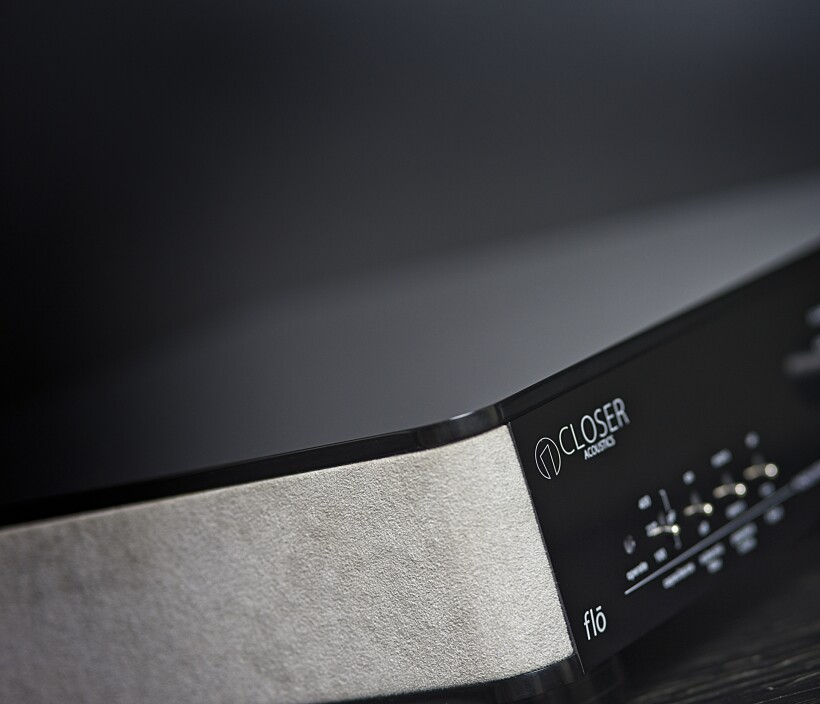
Since concerts are one of the elements of life that I miss the most ever since the pandemic broke out, when I heard such an impressive performance I couldn’t help but listen to each of their albums at least once. And then to even more live performances of other artists, each of which confirmed that the Polish phonostage was able to deliver this extraordinary level of energy that brought back many beautiful memories from unforgettable concerts. Not many devices I know are able to do it in such a convincing manner. The Tenor Audio Phono preamplifier is one of the few that outperformed Closer Acoustics in this (and some other) respect, but it costs several times more, so it remains beyond the reach of the vast majority of audiophiles, including me (unfortunately). The Flō can therefore be a significantly less expensive alternative for lovers of „live-like” energy levels.
Already when listening to the aforementioned RyG albums, I noticed how, despite the seemingly rather gentle overall character, the Flō controls all aspects of the sound with an „iron hand”, so to speak. It does not deliver the most contoured or transient-focused performance I know, but it is difficult to find in it even the slightest signs of loosening control, regardless of music genre or even recording/release quality. Sure, records with „loose” or „boomy” bass won’t be magically fixed by the Closer Acoustics phono, but it will do a better job presenting them in as clean, orderly way as possible, than most competitors (although my ESE Lab Nibiru does equally good job in this regard). Nevertheless, we audiophiles tend to focus on high quality records. And when it comes to them, like on the aforementioned Wackermann’s album, the bass, drums in this case, will sound powerful but remain tight and taut. Yet, when Ray Brown delivers his exceptional, relaxed performance on his double bass, the lowest tones have a naturally soft, delicately sustained character. Still, when the great Miles Davis or the one of the kind Hugh Masakele play their trumpets they sound properly sharp, almost („almost” is a key word here) aggressive and in the next track, if needed, they turn into equally beautiful, though soft and even bit dull sounding instrument. Regardless of how the trumpet sounds like in a chosen recording the Flō is able to convey it just as convincingly, just as true.
And this is the case with virtually every instrument. Of course, this applies primarily to the acoustic ones, because Jessica William, Keith Jarret, but also Lang Lang delighted me with the sound of their pianos, and the latter with the power and vividness of their sound. Mr. Trombone Shorty captivated me with the unique energy of his trombone, and Adderley Cannoball charmed me with the delicacy of the saxophone. However, when it came to Stanley Clarke’s album, not only his double bass, but also the electric bass guitar made quite an impression with realism and raw power of its sound. Rock albums by Pink Floyd, Led Zeppelin, Marillion or Dire Straits sounded properly “heavy”. I had no complaints regarding pace and rhythm, and the sound was dense and properly, as befits such music, “dirty” proving that no music is too big a challenge for Flō and that it is capable of presenting every album in a true and convincing way. Importantly, while the Polish phono fully benefits from the high quality releases, it also allows you to enjoy those of somewhat lesser quality bringing out the best from both kinds.
Summary
The Closer Acoustics Flō is not only a versatile, feature-rich, aesthetically pleasing and well-made phono preamplifier, but also, and perhaps most importantly, a remarkable one in terms of sound quality it offers. Although it’s a solid-state design through and through, so there are no tubes on board, in its performance you can find not only all the most important features or advantages of transistor-based devices, but also those that are attributed (usually rightly so) to vacuum tubes. That is why it impresses with its power, momentum and precision, nicely extended, highly energetic bass, macro-dynamics or a well-organized presentation. Yet, at the same time it delights with spaciousness, openness, micro-dynamics, smoothness, fluidity and expressiveness of the presentation at a level that is hard to find in solid-state models (except, maybe, for the best ones). In a word, it is a truly high end device. I know a handful of phonostages capable of delivering an even more refined, better performance, but all of them cost way, way more than Closer Acoustics product. In this context, the Polish phono is not only a damn good sounding and looking phonostage, but also an attractively priced one.
Let me add that the combination of the Flō and Provocateur 300B SET is also definitely worth your attention. I spent several days using both products of the Polish company in my system and their combined sonic qualities offer even more refined, more captivating sound than what would one expect knowing them from separate listening sessions. In other words – there is definitely a synergy between them. So, if you are on the market for a phono preamplifier offering an original, elegant design, and at the same time feature-rich and delivering a remarkable performance, you should definitely add the Closer Acoustics Flō to a short list of products worth checking out.
Features & Specifications (according to the manufacturer):
- Frequency range (RIAA): 15-50000Hz (+/-0,4dB)
- Passive correction:
1) RIAA
2) CCIR
3) COLUMBIA
4) DECCA
5) TELDEC - Chanel separation: >64dB
- THD: 0,06%
- Input impedance (selectable): 47KΩ – 1KΩ – 400Ω –150Ω – 75Ω – 30Ω
- Gain: 50dB – 55dB – 60dB – 65dB – 69dB – 73dB
- Input capacitance: 100pF – 200pF – 400pF
- Subsonic filter: 15Hz (-18dB)
- Input mode switch: balanced / unbalanced
- Mode switch: mono / stereo
- Input switch: XLR / RCA
Price (when reviewed):
- Closer Acoustics Flō: 9778 EUR (incl. VAT)
Manufacturer: CLOSER ACOUSTICS
Associated equipment:
- Analogue front end: J.Sikora Standard MAX turntable, J.Sikora KV12 tonearm, AirTight PC-3, phonostages: Grandinote Celio mk IV, ESE Lab Nibiru V 5.
- Digital source: a passive, custom PC with WIN10, Roon, Fidelizer Pro 7.10, JCat USB Femto card with iFi power supply, Hdplex linear power supply for PC, JCAT USB Isolator
- D/A Converter: LampizatOr Pacific +Ideon Audio 3R Master Time (USB signal regenerator)
- Power amplifier: GrandiNote Shinai, LampizatOr Metamorphosis, Art Audio Symphony II (modified)
- Preamplifier: Audia Flight FLS1
- Loudspeakers: GrandiNote MACH4, Ubiq Audio Model ONE Duelund Edition.
- Interconnects: Hijiri Million, Hijiri HCI-20, TelluriumQ Ultra Black, KBL Sound Zodiac XLR, David Laboga Expression Emerald USB, TelluriumQ Silver USB
- Speaker cables: LessLoss Anchorwave
- Power cables: LessLoss DFPC Signature, Gigawatt LC-3
- Power: Gigawatt PF-2 MK2 and Gigawatt PC-3 SE Evo+; a custom power line with Gigawatt LC-Y in-wall cable; Gigawatt G-044 Schuko and Furutech FT-SWS-D (R)
- Racks: Base VI, Rogoz Audio 3RP3/BBS
- Anti-vibration accessories: ROGOZ-AUDIO SMO40 and CPPB16 platforms and ROGOZ AUDIO BW40MKII feet, Franc Accessories Ceramic Disc Slim Feet and Wood Block Platform



